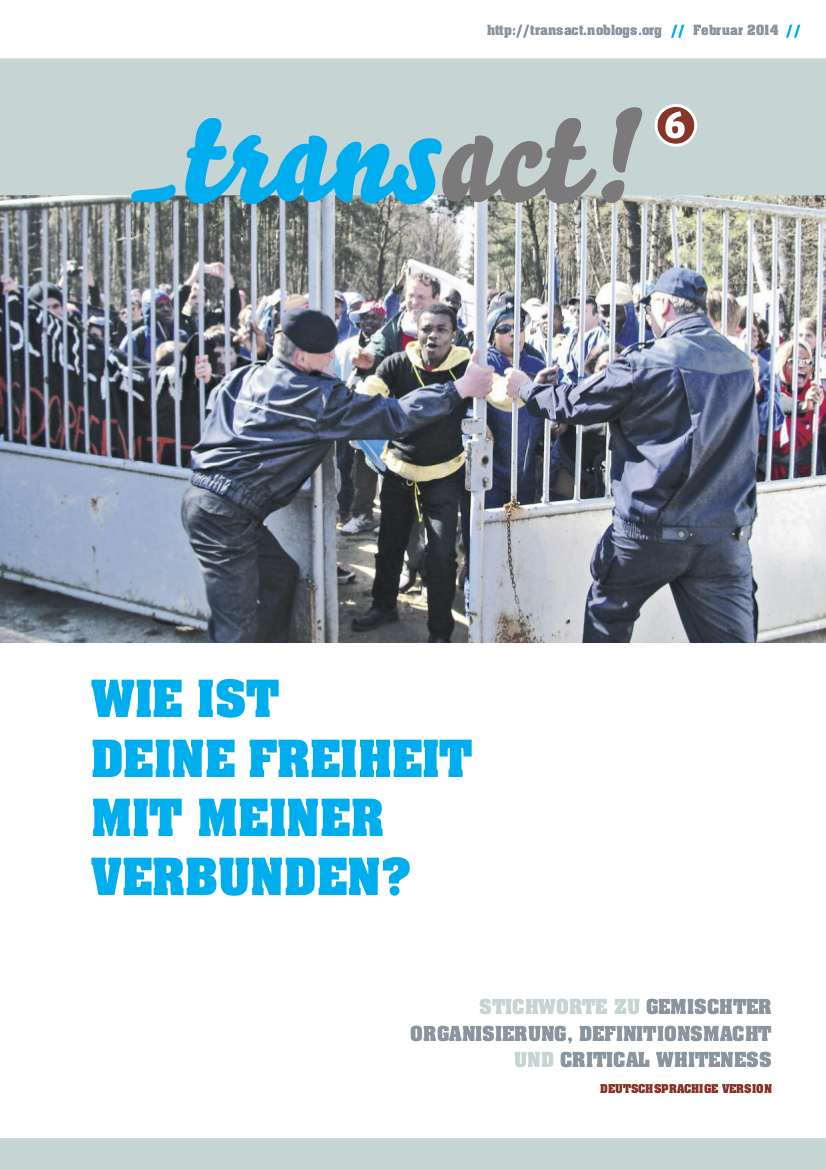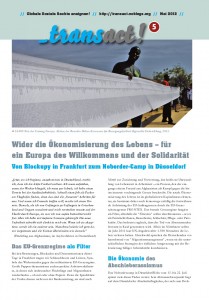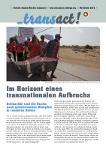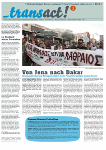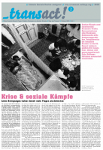An evaluation of the no border camp in Lesvos at the end of August
Never before have we experienced a noborder camp on the outer borders
of the EU at which political protests and social struggles for the
freedom of movement were as intertwined as they were in Lesvos.
International press coverage about the detention centre Pagani was
considerable and we return with many new impulses for transnational
networking. Even if meetings were characterised by strong
disagreements, our evaluation of Lesvos is overwhelmingly positive.(1)
“Tomorrow when we continue our journey, we will be refugees again. But
till the last minute we will be just people here tonight, friends
celebrating together. Who would’ve thought that on this island we
wouldn’t have to hide in the woods and that we would get the gift of a
night of freedom amongst friends!”
These words speak volumes. They are the words of a young Afghani man on the last night of the noborder camp
that took place near Mytilini, the capital of the island of Lesvos.
True words they are, given the impressive events of those days, in
particular at the Infopoint which was set up along the harbour right
from the start. There tourists could get information about the
situation of refugees, whilst (silent) supporters from the island
brought blankets and food. Some of the locals also shared the
experiences they had had with refugees. Within a few days, this
self-organised ‘Welcome Centre’ became the central meeting point for
(paperless) newcomers and released detainees; a space to rest, a space
to exchange information and a space for collective action.(2)
As we expected, both time and place of the noborder camp were
well-selected. Lesvos is key site in the external border regime of the
EU: Each night new refugee boats arrived and the detention centre at
Pagani had been suffering from overcrowding for weeks. Greek border
guards and Frontex were on patrol around the clock.(3) Around 600
activists from many different countries had travelled to Lesvos for the
week of protests. Aside from the Greek activists, most of them were
from Germany, but also from many different countries. Five days before
the noborder camp began, 150 young people detained in Pagani went on
hunger strike to demand their release. This set the tone and of what
was about to unfold. The first solidarity actions began then, producing
the kinds of images that would cause stirs in the international media
in the weeks to come: refugees smuggled a camera into the prison to
document the inhumane conditions forced on them inside.(4) With a
slight delay, these even made it onto CNN and some of this material was
also broadcast in the German media. However, both press work within
Greece as well as on an international level could have been even more
effective if engagement with mainstream media hadn’t been such a
controversial issue.(5)
The first contentious issue that emerged was a familiar one to
activists in Germany: 40 hunger strikers had fought their way out of
Pagani and were waiting for the crossing to Athens with nowhere to stay
and without any resources. The places on the ferries were all booked up
and they couldn’t leave, so they were invited to join the camp.
Immediately people began to worry how to continue to do political
actions when hundreds of refugees needed to be cared for. Many –
especially local activists – feared getting lost in individual support
work and being instrumentalised by the state in the process. What was
at stake here was the possibility of connecting practical solidarity
with political demands. Unfortunately though, it remained a theoretical
debate in meetings as to how dynamic resistance could unfold through
joining together social (survival) struggles and political initiatives.
This was why the Infopoint was such an astute compromise.
At the Infopoint, noborder activists wanting to confront the border
regime politically could come together with those whose journey to
Europe was a practical challenge to those borders. Through this
process, refugees and activists were able to break through language
barriers and organise mutual support as well as collective (political!)
action. The kitchen collectives brought food and noborder activists
offered medical assistance, legal advice and practical help for people
continuing their journey. Experienced migrants translated and shared
what they had learned along the way, those who were more rested helped
the exhausted newcomers. New arrivals participated in farewell parades
for those embarking on their journey towards Athens. Setting a
precedence, an Afghani family fought and won the ability to register
without detention! For the Frontex action day, refugees and activists
painted a huge multi-language ‘Freedom of Movement’ banner and hung it
up at the Infopoint. It’s not always easy to get the balance between
care and activism or negotiations and street actions right, and so
everyone’s emotional and physical boundaries were constantly being
pushed to their limits. Yet it was precisely this process that appeared
to us to be one of the most powerful aspects of the noborder camp.
From the moment the hunger strikes happened shortly before noborder09
began, it was clear that the detention centre would become a main focal
point. Pagani was completely overcrowded with at times 1000 men, women
and children locked away in appalling conditions lacking in hygiene as
well as access to food and water. Nearly every day, larger and smaller
actions took place with calls of “Freedom! Azadi!” resounding from
inside and out. Protesters shook the gates of the prison, occupied the
courtyard and in the end also the roof. A source of long and bitter
debates was whether and how to have forced a mass break-out and close
down the prison. Wouldn’t that have been the only appropriate action
(and technically possible)? However, people inside were clear that they
didn’t want to break out like ‘criminals’, they wanted to be released
(people also feared still having to encounter the authorities at the
ferry port, a chokepoint if you want to go further). And so – at least
for the duration of the noborder camp – the strategy was to put
continued pressure on the authorities from inside and out, to shorten
the time refugees were physically detained and to transform the prison
into open centre.
This debate led straight into inextricably linked discussions about
action repertoires, repeatedly surfacing in all meetings and working
groups. Already in advance, intense conflicts had ensued within the
Greek networks: anarchist groups weren’t participating because they
couldn’t work with the “network for political and social rights”
(‚Diktio‘). Autonomous and anarchist groups from other countries
expected more direct actions and consistently felt like they were being
restricted when they made concrete proposals for actions. It’s true
that many ideas for actions were blocked, either because of fears that
these wouldn’t be carried out responsibly, or because these might
endanger other (in some cases actually also questionable) negotiation
tactics. Additionally, huge communication problems existed that had to
do with different protest cultures as well as (often non-transparent)
decision-making processes. Also, the riot cops brought in from Athens
did anything but make any of the actions easier. Completely out of the
blue they would use their batons to demonstrate that civil disobedience
wouldn’t be met with any kind of civil response. Another difficulty
were conflicts around different sensitivities in given situations. A
good example here was the attempt (thwarted by other activists) by a
few small groups to break out of the demonstration in the inner-city
harbour area to do a militant action – against clear agreements within
the incredibly heterogeneous preparatory group that had organised the
demo, along with repeated pleas by local activists. Overall, lamentably
(and this is directed at everyone), we weren’t successful at carrying
out self-organised and well-prepared actions that directly confronted
the infrastructure of Frontex, Coastguard & Co.
There was quite a buzz on the Frontex-action day when activists in 50
paddle boats attempted to surround the Coastguard. Of course the Greek
coast guards were ‘nice enough’ to display their finesse in making
waves that push back refugee boats at high sea. At the same time as
this was going on, the demo against Frontex started, led – amongst
others – by activists from Mali and Mauretania, who in West Africa are
also faced with EU border agency operations. In workshops it was
possible to strengthen transnational networking with them as well as
activists from Eastern Europe and Turkey, meaning that more joint
initiatives against Frontex and illegal deportations (‚refoulements‘)
along the EU’s outer borders are planned for the future. More than ever
before, noborder09 left behind sustainable structures on a local level.
The week of protests invigorated and strengthened the local support
group which continues to raise public awareness of the scandalous
conditions in Pagani, not least because new detainees continue to
rebel. Clearly motivated by noborder09 events, the following weeks saw
more protests which have now led to the re-instatement of an open
centre. Newly arrived families should be registered there without being
detained, a small but real shift from the existing practice of
deterrence. Additionally, the ‘Voices of Pagani’ have made
Dublin-refoulements more difficult, and against the backdrop of the
successful fast-track appeal at the German Constitutional Court, it’s
no coincidence that Schaeuble has complained at Greece endangering the
whole Dublin-System. (6)
Via the Infopoint, noborder09 came into contact with an estimated 200
Sans Papiers and was able to undermine the existing registration and
internment system during the days of the noborder camp. The contacts
established have been maintained beyond Athens and refugees who have
made it to where they wanted to go have already been in touch! For a
few moments, the Infopoint allowed us gain a glimpse of what a
self-organised “Welcome-Centre” could look like. The words of a young
woman from Somalia leave no doubt at all: “I am most thankful to have
learned that there is more than one journey. When I left Somalia, I
started my journey to find a safer and better place to live, because I
wanted to support my family. I can now see more clearly what Europe
looks like and how it isn’t the safe place I hoped to reach. We are
thrown into terrible prisons and Europe sends its troops to fight us at
sea. I have never learned so much in such a short time. It was
difficult to learn, but I learnt even more. I began my second journey
here, seeing all the others who sit in the same little boats and fight
for survival and to get further. In the last days together with you
here in this tent in Mytilini I have been able to see what it would be
like if we all go on the journey together. Maybe to another place that
might exist somewhere in the future.”
transact! October 2009
(*) ‘Azadi’ is Farci for ‘Freedom’.
(1) See also http://lesvos09.antira.info/, as well as http://birdsofimmigrants.jogspace.net/biographi
(2) A separate brochure about the Infopoint will be published in the coming months.
(3) In Pagani refugees’ fingerprints are taken and subsequently they
are detained (between 2 weeks and 2 months) until they receive a ‘white
paper’ stating that they have to leave Greece within 30 days.
(4) This and other videos can be viewed here: http//lesvos09.antira.info/nobordertv/
(5) Before the noborder camp there was a decision taken by the local
group that the noborder camp as a whole shouldn’t engage in any
mainstream media work.
(6) In September 2009 the Constitutional Court stopped a deportation of
a refugee from Irak in a summary proceeding. The man should have been
deported to Greece which was the country of his first entry to European
Union. Schäuble (Germany’s Interior Minister since elections in
September) is one of the hardest opponents to any kind of reform on
Dublin2-convention.

